What Job Can I Get If I Draw In Pencil
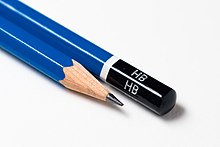
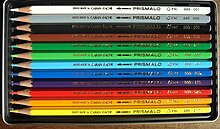

A pencil () is a writing or drawing implement with a solid pigment core encased in a sleeve, barrel, or shaft that prevents breaking the core or marking a user's hand.
Pencils create marks by physical abrasion, leaving a trail of solid core material that adheres to a sheet of paper or other surface. They are distinct from pens, which dispense liquid or gel ink onto the marked surface.
About pencil cores are fabricated of graphite pulverization mixed with a clay binder. Graphite pencils (traditionally known every bit "lead pencils") produce grayness or black marks that are easily erased, but otherwise resistant to wet, most chemicals, ultraviolet radiation and natural aging. Other types of pencil cores, such as those of charcoal, are mainly used for drawing and sketching. Coloured pencils are sometimes used by teachers or editors to correct submitted texts, but are typically regarded as art supplies, especially those with cores made from wax-based binders that tend to smear when erasers are practical to them. Grease pencils have a softer, oily core that can leave marks on smooth surfaces such as glass or porcelain.
The nearly mutual pencil casing is thin wood, usually hexagonal in department but sometimes cylindrical or triangular, permanently bonded to the core. Casings may exist of other materials, such equally plastic or paper. To employ the pencil, the casing must be carved or peeled off to betrayal the working terminate of the cadre as a sharp point. Mechanical pencils take more elaborate casings which are not bonded to the core; instead, they support separate, mobile pigment cores that tin be extended or retracted (usually through the casing'south tip) equally needed. These casings tin exist reloaded with new cores (usually graphite) as the previous ones are wearied.
History

Old Soviet colored pencils with box (circa 1959)
Camel'south pilus
Pencil, from Old French pincel, from Latin penicillus a "little tail" (see penis; pincellus is Latin from the post-classical period[one]) originally referred to an artist'due south fine brush of camel hair, likewise used for writing earlier modern lead or chalk pencils.[2]
Though the archetypal pencil was an creative person'southward castor, the stylus, a thin metal stick used for scratching in papyrus or wax tablets, was used extensively past the Romans[3] and for palm-leaf manuscripts.
Graphite deposit discoveries
As a technique for cartoon, the closest predecessor to the pencil was silverpoint or leadpoint until in 1565 (some sources say as early as 1500), a big eolith of graphite was discovered on the arroyo to Grey Knotts from the hamlet of Seathwaite in Borrowdale parish, Cumbria, England.[4] [v] [6] [seven] This item deposit of graphite was extremely pure and solid, and information technology could easily be sawn into sticks. It remains the simply big-calibration deposit of graphite ever institute in this solid form.[eight] Chemistry was in its infancy and the substance was thought to exist a form of pb. Consequently, it was called plumbago (Latin for "atomic number 82 ore").[9] [10] Because the pencil core is still referred to as "pb", or "a lead", many people have the misconception that the graphite in the pencil is lead,[11] and the black cadre of pencils is still referred to as pb, even though information technology never contained the element lead.[12] [13] [fourteen] [15] [16] [17] The words for pencil in German (Bleistift), Irish (peann luaidhe), Arabic (قلم رصاص qalam raṣāṣ), and another languages literally hateful lead pen.
The value of graphite would shortly exist realised to be enormous, mainly because it could be used to line the moulds for cannonballs; the mines were taken over by the Crown and were guarded. When sufficient stores of graphite had been accumulated, the mines were flooded to prevent theft until more was required.
The usefulness of graphite for pencils was discovered every bit well, but graphite for pencils had to be smuggled. Because graphite is soft, information technology requires some form of encasement. Graphite sticks were initially wrapped in cord or sheepskin for stability. England would enjoy a monopoly on the product of pencils until a method of reconstituting the graphite powder was institute in 1662 in Italy. However, the distinctively square English language pencils continued to be made with sticks cut from natural graphite into the 1860s. The town of Keswick, most the original findings of block graphite, still manufactures pencils, the factory also being the location of the Derwent Pencil Museum.[xviii] The meaning of "graphite writing implement" apparently evolved late in the 16th century.[nineteen]
Wood encasement
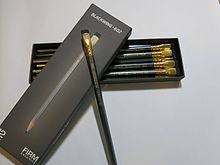
Palomino Blackwing 602 pencils
Around 1560,[twenty] an Italian couple named Simonio and Lyndiana Bernacotti made what are probable the first blueprints for the modern, woods-encased carpentry pencil. Their version was a flat, oval, more than compact type of pencil. Their concept involved the hollowing out of a stick of juniper forest. Soon thereafter, a superior technique was discovered: 2 wooden halves were carved, a graphite stick inserted, and the halves so glued together—essentially the same method in utilize to this day.[21]
Graphite pulverization and clay
The first try to manufacture graphite sticks from powdered graphite was in Nuremberg, Germany, in 1662. It used a mixture of graphite, sulphur, and antimony.[22] [23] [24]
English language and German pencils were not available to the French during the Napoleonic Wars; French republic, under naval blockade imposed by Great United kingdom of great britain and northern ireland, was unable to import the pure graphite sticks from the British Grey Knotts mines – the just known source in the world. France was besides unable to import the junior High german graphite pencil substitute. It took the efforts of an officer in Napoleon's army to modify this. In 1795, Nicolas-Jacques Conté discovered a method of mixing powdered graphite with dirt and forming the mixture into rods that were and then fired in a kiln. By varying the ratio of graphite to clay, the hardness of the graphite rod could too be varied. This method of manufacture, which had been earlier discovered by the Austrian Joseph Hardtmuth, the founder of the Koh-I-Noor in 1790, remains in use.[25] In 1802, the production of graphite leads from graphite and clay was patented by the Koh-I-Noor visitor in Vienna.[26]
In England, pencils continued to exist made from whole sawn graphite. Henry Bessemer's showtime successful invention (1838) was a method of compressing graphite pulverisation into solid graphite thus allowing the waste product from sawing to be reused.[27]
United States

Pencil, perhaps made by Henry David Thoreau, in the Concord Museum
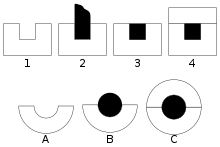
Pencil manufacturing. The height sequence shows the erstwhile method that required pieces of graphite to exist cut to size; the lower sequence is the new, current method using rods of graphite and clay.
American colonists imported pencils from Europe until later on the American Revolution. Benjamin Franklin advertised pencils for sale in his Pennsylvania Gazette in 1729, and George Washington used a three-inch pencil when he surveyed the Ohio State in 1762.[28] [ better source needed ] William Munroe, a cabinetmaker in Concur, Massachusetts, fabricated the first American forest pencils in 1812. This was not the just pencil-making occurring in Concord. According to Henry Petroski, transcendentalist philosopher Henry David Thoreau discovered how to make a skillful pencil out of inferior graphite using clay as the binder; this invention was prompted past his father's pencil factory in Concord, which employed graphite constitute in New Hampshire in 1821 past Charles Dunbar.[vii]
Munroe's method of making pencils was painstakingly wearisome, and in the neighbouring boondocks of Acton, a pencil mill owner named Ebenezer Woods set out to automate the process at his own pencil mill located at Nashoba Brook. He used the first circular saw in pencil production. He constructed the first of the hexagon- and octagon-shaped wooden casings. Ebenezer did non patent his invention and shared his techniques with anyone. One of those was Eberhard Faber, which built a manufacturing plant in New York and became the leader in pencil production.[29]
Joseph Dixon, an inventor and entrepreneur involved with the Tantiusques graphite mine in Sturbridge, Massachusetts, developed a means to mass-produce pencils. Past 1870, The Joseph Dixon Crucible Company was the world's largest dealer and consumer of graphite and later became the contemporary Dixon Ticonderoga pencil and fine art supplies visitor.[thirty] [31]
By the finish of the 19th century, over 240,000 pencils were used each day in the US. The favoured timber for pencils was Blood-red Cedar as it was aromatic and did not splinter when sharpened. In the early 20th century supplies of Crimson Cedar were dwindling and then that pencil manufacturers were forced to recycle the wood from cedar fences and barns to maintain supply.
One effect of this was that "during Globe War II rotary pencil sharpeners were outlawed in Britain considering they wasted so much deficient atomic number 82 and forest, and pencils had to exist sharpened in the more conservative manner – with knives."[32]
It was soon discovered that Incense cedar, when dyed and perfumed to resemble Carmine Cedar, was a suitable alternative. Most pencils today are made from this timber, which is grown in managed forests. Over fourteen billion pencils are manufactured worldwide annually.[33] Less popular alternatives to cedar include basswood and alder.[32]
In Southeast Asia, the wood Jelutong may exist used to create pencils (though the use of this rainforest species is controversial).[34] Environmentalists prefer the use of Pulai – another wood native to the region in pencil manufacturing.[35] [36]
Eraser zipper

Attached eraser on the left; Pencil lead on the right
On March 30, 1858, Hymen Lipman received the first patent for attaching an eraser to the end of a pencil.[37] In 1862, Lipman sold his patent to Joseph Reckendorfer for $100,000, who went on to sue pencil manufacturer Faber-Castell for infringement.[38] In 1875, the Supreme Court of the US ruled against Reckendorfer declaring the patent invalid.[39]
Extenders
Historian Henry Petroski notes that while always more than efficient means of mass production of pencils has driven the replacement cost of a pencil down, before this people would continue to utilize fifty-fifty the stub of a pencil. For those who did not experience comfortable using a stub, pencil extenders were sold. These devices function something similar a porte-crayon...the pencil stub can exist inserted into the end of a shaft...Extenders were peculiarly common amidst engineers and draftsmen, whose favorite pencils were priced dearly. The use of an extender likewise has the advantage that the pencil does not appreciably change its heft as it wears downwards."[32] Artists currently apply extenders to maximize the use of their colored pencils.
Types
By marking material


Graphite
Graphite pencils are the most common types of pencil, and are encased in wood. They are fabricated of a mixture of clay and graphite and their darkness varies from light gray to black. Their composition allows for the smoothest strokes.
Solid
Solid graphite pencils are solid sticks of graphite and clay composite (every bit institute in a 'graphite pencil'), about the bore of a common pencil, which take no casing other than a wrapper or label. They are oftentimes chosen "woodless" pencils. They are used primarily for fine art purposes equally the lack of casing allows for roofing larger spaces more hands, creating different effects, and providing greater economy equally the entirety of the pencil is used. They are available in the same darkness range as woods-encased graphite pencils.
Liquid
Liquid graphite pencils are pencils that write similar pens. The technology was first invented in 1955 by Scripto and Parker Pens. Scripto's liquid graphite formula came out about three months before Parker's liquid lead formula. To avert a lengthy patent fight the two companies agreed to share their formulas.[40]
Charcoal
Charcoal pencils are made of charcoal and provide fuller blacks than graphite pencils, but tend to smudge hands and are more abrasive than graphite. Sepia-toned and white pencils are likewise bachelor for duotone techniques.
Carbon pencils
Carbon pencils are generally made of a mixture of clay and lamp black, but are sometimes composite with charcoal or graphite depending on the darkness and manufacturer. They produce a fuller black than graphite pencils, are smoother than charcoal, and take minimal dust and smudging. They also blend very well, much similar charcoal.
Colored
Colored pencils, or pencil crayons, have wax-similar cores with pigment and other fillers. Several colors are frequently blended together.[41]
Grease
Grease pencils can write on virtually any surface (including glass, plastic, metal and photographs). The virtually commonly found grease pencils are encased in paper (Berol and Sanford Peel-off), simply they can also be encased in wood (Staedtler Omnichrom).[41]
Watercolor
Watercolor pencils are designed for use with watercolor techniques. Their cores can be diluted by water. The pencils tin can be used past themselves for sharp, bold lines. Strokes made by the pencil can likewise be saturated with water and spread with brushes.[41]
By use
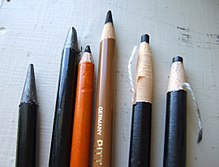
Two "woodless" graphite pencils, two charcoal pencils, and two grease pencils
Carpentry
Carpenter's pencils are pencils that have two main properties: their shape prevents them from rolling, and their graphite is strong.[42] The oldest surviving pencil is a German carpenter's pencil dating from the 17th Century and now in the Faber-Castell collection.[43] [44]
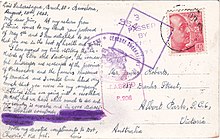
Obliteration by indelible pencil to censor mail in 1943
Copying
Copying pencils (or indelible pencils) are graphite pencils with an added dye that creates an indelible marker. They were invented in the tardily 19th century for press copying and equally a practical substitute for fountain pens. Their markings are often visually indistinguishable from those of standard graphite pencils, but when moistened their markings dissolve into a coloured ink, which is then pressed into another piece of newspaper. They were widely used until the mid-20th century when ball pens slowly replaced them. In Italy their apply is still mandated past police for voting paper ballots in elections and referendums.[45]
Eyeliner
Eyeliner pencils are used for brand-upwardly. Unlike traditional copying pencils, eyeliner pencils usually contain not-toxic dyes.[46]
Erasable coloring
Unlike wax-based colored pencils, the erasable variants tin be hands erased. Their principal use is in sketching, where the objective is to create an outline using the same color that other media (such equally wax pencils, or watercolor paints) would fill up[47] or when the objective is to scan the color sketch.[48] Some animators prefer erasable color pencils as opposed to graphite pencils because they do not smudge equally hands, and the dissimilar colors allow for better separation of objects in the sketch.[49] Copy-editors find them useful besides as markings stand out more than those of graphite, but tin be erased.
Non-reproduction
Also known equally non-photo blue pencils, the non-reproducing types make marks that are not reproducible by photocopiers[l] (examples include "Re-create-not" by Sanford and "Mars Non-photo" by Staedtler) or by whiteprint copiers (such as "Mars Non-Print" past Staedtler).
Stenography
Stenographer's pencils, as well known as a steno pencil, are expected to be very reliable, and their lead is break-proof. Nevertheless, steno pencils are sometimes sharpened at both ends to enhance reliability. They are circular to avoid pressure pain during long texts.[51]
Golf
Golf pencils are usually short (a common length is 9 cm (3.v in)) and very inexpensive. They are likewise known every bit library pencils, every bit many libraries offer them as disposable, leak-proof[52] writing instruments.
By shape
- Triangular (more accurately a Reuleaux triangle)
- Hexagonal
- Circular
- Bendable (flexible plastic)
By size
Typical
A standard, hexagonal, "#ii pencil" is cut to a hexagonal superlative of one⁄iv -inch (vi mm), but the outer diameter is slightly larger (about 9⁄32 -inch (7 mm)) A standard, #2, hexagonal pencil is 19 cm (7.5 in) long.
Biggest
On 3 September 2007, Ashrita Furman unveiled his behemothic US$twenty,000 pencil – 76 feet (23 m) long, eighteen,000 pounds (viii,200 kg) (with over 4,500 pounds (ii,000 kg) for the graphite centre) – subsequently three weeks of creation in August 2007 equally a altogether souvenir for teacher Sri Chinmoy. It is longer than the 65-pes (xx 1000) pencil outside the Malaysia HQ of stationers Faber-Castell.[53] [54] [55]
By manufacture
Mechanical
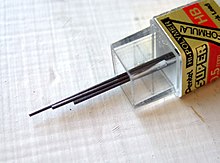
Pb for mechanical pencils

Mechanical pencils utilise mechanical methods to push lead through a hole at the finish. These can be divided into two groups: with propelling pencils an internal machinery is employed to push the atomic number 82 out from an internal compartment, while clutch pencils just agree the lead in identify (the lead is extended by releasing it and allowing some external force, unremarkably gravity, to pull information technology out of the trunk). The erasers (sometimes replaced by a sharpener on pencils with larger lead sizes) are too removable (and thus replaceable), and usually cover a place to shop replacement leads. Mechanical pencils are popular for their longevity and the fact that they may never need sharpening. Lead types are based on grade and size; with standard sizes being ii.00 mm (0.079 in), 1.twoscore mm (0.055 in), one.00 mm (0.039 in), 0.70 mm (0.028 in), 0.l mm (0.020 in), 0.35 mm (0.014 in), 0.25 mm (0.0098 in), 0.18 mm (0.0071 in), and 0.xiii mm (0.0051 in) (ISO 9175-1)—the 0.ninety mm (0.035 in) size is available, merely is not considered a standard ISO size.[ citation needed ]
Pop a Signal
Pioneered by Taiwanese stationery manufacturer Bensia Pioneer Industrial Corporation in the early 1970s, Popular a Point Pencils are as well known every bit Bensia Pencils, stackable pencils or non-sharpening pencils. It is a type of pencil where many short pencil tips are housed in a cartridge-fashion plastic holder. A edgeless tip is removed by pulling it from the writing finish of the body and re-inserting it into the open-ended bottom of the body, thereby pushing a new tip to the top.
Plastic
Invented by Harold Grossman[56] for the Empire Pencil Company in 1967, plastic pencils were subsequently improved upon by Arthur D. Niggling for Empire from 1969 through the early on 1970s; the plastic pencil was commercialised past Empire every bit the "EPCON" Pencil. These pencils were co-extruded, extruding a plasticised graphite mix within a forest-composite core.[57]
Other aspects
- By factory state: sharpened, unsharpened.
- By casing fabric: wood, paper, plastic.
Health
Residual graphite from a pencil stick is not poisonous, and graphite is harmless if consumed.
Although lead has non been used for writing since antiquity, such equally in Roman styli, lead poisoning from pencils was not uncommon. Until the center of the 20th century the paint used for the outer coating could incorporate high concentrations of lead, and this could be ingested when the pencil was sucked or chewed.[58] [ additional citation(s) needed ]
Manufacture
The lead of the pencil is a mix of finely basis graphite and dirt powders. Before the two substances are mixed, they are separately cleaned of foreign matter and dried in a manner that creates large foursquare cakes. Once the cakes have fully dried, the graphite and the clay squares are mixed together using water. The corporeality of dirt content added to the graphite depends on the intended pencil hardness (lower proportions of clay makes the core softer),[59] and the amount of time spent on grinding the mixture determines the quality of the lead. The mixture is then shaped into long spaghetti-like strings, straightened, dried, cut, and so tempered in a kiln. The resulting strings are dipped in oil or molten wax, which seeps into the tiny holes of the material and allows for the smooth writing power of the pencil. A juniper or incense-cedar plank with several long parallel grooves is cutting to manner a "slat," and the graphite/clay strings are inserted into the grooves. Another grooved plank is glued on superlative, and the whole assembly is so cutting into individual pencils, which are so varnished or painted. Many pencils characteristic an eraser on the top and so the process is usually even so considered incomplete at this signal. Each pencil has a shoulder cut on one end of the pencil to allow for a metal ferrule to be secured onto the forest. A rubber plug is then inserted into the ferrule for a functioning eraser on the end of the pencil.[60]
Grading and classification

Ii graphite pencils. Both are labelled "HB", only the numeric label differs between "two" and "2
i⁄two "

A grading nautical chart ranging from 9B to 9H
Graphite pencils are fabricated of a mixture of clay and graphite and their darkness varies from light grey to black: the more than clay the harder the pencil.[61] [62] [63] There is a wide range of grades available, mainly for artists who are interested in creating a full range of tones from light gray to black. Engineers adopt harder pencils which allow for a greater control in the shape of the lead.
Manufacturers distinguish their pencils past grading them, merely there is no common standard.[64] Two pencils of the same class but different manufacturers will not necessarily make a marker of identical tone nor accept the same hardness.[65]
About manufacturers, and almost all in Europe, designate their pencils with the letters H (commonly interpreted as "hardness") to B (normally "blackness"), every bit well as F (usually taken to hateful "fineness", although F pencils are no more than fine or more easily sharpened than any other form. Also known as "business firm" in Nihon[66]). The standard writing pencil is graded HB.[67] [a] This designation was in apply at to the lowest degree every bit early equally 1844.[68] It used B for black and H for hard; a pencil'southward form was described by a sequence or successive Hs or Bs such as BB and BBB for successively softer leads, and HH and HHH for successively harder ones.[69] The Koh-i-Noor Hardtmuth pencil manufacturers claim to have first used the HB designations, with H continuing for Hardtmuth, B for the company'south location of Budějovice, and F for Franz Hardtmuth, who was responsible for technological improvements in pencil manufacture.[seventy] [71]
Equally of 2022, a set of pencils ranging from a very soft, black-marking pencil to a very hard, low-cal-marking pencil unremarkably ranges from softest to hardest every bit follows:
| Tone and class designations | Character | Application examples | ||
|---|---|---|---|---|
| Europe | USA | RUS | ||
| 9B | – | – | extremely soft, black | for artistic purposes:
|
| 8B | – | – | ||
| 7B | – | – | ||
| 6B | – | – | ||
| 5B | – | – | ||
| 4B | – | – | ||
| 3B | – | 3M | soft |
|
| 2B | #0 | 2М | ||
| B | #ane | One thousand | ||
| HB | #2 | TM | medium |
|
| F | #two½* | – | ||
| H | #three | T | hard |
|
| 2H | #4 | 2T | ||
| 3H | – | 3T | very hard |
|
| 4H | – | – | ||
| 5H | – | – | ||
| 6H | – | – | extremely hard, light grey | for special purposes:
|
| 7H | – | – | ||
| 8H | – | – | ||
| 9H | – | – | ||
| *Also seen every bit two 2 / iv , 2 4 / 8 , 2.5, 2 v / ten | ||||
Koh-i-noor offers twenty grades from 10H to 8B for its 1500 serial.[72] Mitsubishi Pencil offers xx-two grades from 10H to 10B for its Hello-uni range.[73] Derwent produces xx grades from 9H to 9B for its graphic pencils.[74] Staedtler produces 24 from 10H to 12B for its Mars Lumograph pencils.[75]
Numbers as designation were first used by Conté and after by John Thoreau, father of Henry David Thoreau, in the 19th century.[76] Although Conté/Thoreau's equivalence table is widely accepted,[ citation needed ] not all manufacturers follow it; for instance, Faber-Castell uses a dissimilar equivalence tabular array in its Grip 2001 pencils: 1 = 2B, 2 = B, ii½ = HB, three = H, iv = 2H.
Hardness test
Graded pencils can be used for a rapid test that provides relative ratings for a serial of coated panels but tin't be used to compare the pencil hardness of different coatings. This test defines a "pencil hardness" of a coating equally the grade of the hardest pencil that does not permanently marking the coating when pressed firmly against it at a 45 degree angle.[77] [78] For standardized measurements, at that place are Mohs hardness testing pencils on the market.
External colour and shape

A typical yellow no. 2 pencil
The majority of pencils made in the US are painted xanthous.[79] According to Henry Petroski,[80] this tradition began in 1890 when the L. & C. Hardtmuth Visitor of Austro-hungarian empire introduced their Koh-I-Noor brand, named after the famous diamond. It was intended to exist the world's best and nigh expensive pencil, and at a time when near pencils were either painted in night colours or non at all, the Koh-I-Noor was xanthous. As well equally simply beingness distinctive, the colour may have been inspired by the Austro-Hungarian flag; it was also suggestive of the Orient at a time when the best-quality graphite came from Siberia. Other companies and then copied the yellow colour and then that their pencils would be associated with this high-quality brand, and chose brand names with explicit Oriental references, such as Mikado (renamed Mirado)[81] [82] and Mongol.[83] [84]
Not all countries employ yellowish pencils. German and Brazilian pencils, for example, are ofttimes green, blue or black, based on the trademark colours of Faber-Castell, a major German stationery company which has plants in those countries. In southern European countries, pencils tend to be dark red or blackness with yellow lines, while in Australia, they are red with blackness bands at one end.[85] In India, the most common pencil colour scheme was dark red with black lines, and pencils with a big number of colour schemes are produced.[ commendation needed ]
Pencils are unremarkably round, hexagonal, or sometimes triangular in section. Carpenters' pencils are typically oval or rectangular, so they cannot hands roll away during piece of work.
Notable users
- Thomas Edison had his pencils specially made by Eagle Pencil. Each pencil was three inches long, was thicker than standard pencils and had softer graphite than was usually available.[33]
- Charles Fraser-Smith During Globe State of war II, Fraser-Smith worked for the Ministry of Supply, fabricating equipment nicknamed "Q-devices" (later Q-ships) for SOE agents operating in occupied Europe. In 1942, Charles Fraser-Smith, who worked in MI9, arrived at the Cumberland pencil factory, he had an idea to create a secret map and compass pencil. These were given to Lancaster Bomber airmen and were fabricated secretly nether the Official Secrets Human action, in Keswick.[86]
- Vladimir Nabokov rewrote everything he had ever published, usually several times, in pencil.[33]
- John Steinbeck was an obsessive pencil user and is said[ by whom? ] to have used as many as sixty a day. His novel East of Eden took more than than 300 pencils to write.[33]
- Vincent van Gogh used only Faber pencils as they were "superior to Carpenters pencils, a capital black and well-nigh amusing".[33] [87]
- Johnny Carson regularly played with pencils at his Tonight Testify desk-bound. These pencils were particularly made with erasers at both ends to avoid on-prepare accidents.[88]
- Roald Dahl used only pencils with yellowish casing to write his books. He had 6 sharpened pencils ready at the beginning of each 24-hour interval and simply when all 6 pencils became unusable did he resharpen them.[89]
Manufacturers

A drove of pencils (12) past Bohemia Works Czech Democracy from the Ministry of Construction of the GDR in the stock of the MEK
Prominent global manufacturers of wood-cased (including wood-free) pencils:
| Manufacturer | State of origin | Remark |
|---|---|---|
| Caran d'Ache | Switzerland | |
| Communist china First Pencil Co. | China | "Chung hwa" and "Groovy Wall" brands |
| Cretacolor Bleistiftfabrik | Austria | |
| Derwent Cumberland Pencil Company | UK | Derwent make |
| Dixon Ticonderoga | United states | Dixon, Oriole, Ticonderoga brands (manufactured in Mexico, Communist china) |
| Faber-Castell AG | Frg | Plants in Germany, Indonesia, Costa Rica, Brazil |
| FILA Group | Italy | Owns Lyra, Dixon, Ticonderoga brands |
| General Pencil Co. | USA | General'south, Kimberly brands |
| Hindustan Pencils | India | Apsara, Nataraj brands |
| Koh-i-Noor Hardtmuth | Czech republic | Koh-i-Noor brand |
| Lyra Bleistift-Fabrik | Germany | Parent: FILA Group |
| Mitsubishi Pencil Company | Japan | Mitsu-Bishi, Uni brands |
| Musgrave Pencil Company | Usa | |
| Newell Brands | USA | Paper Mate make |
| Palomino | Us | Division of California Cedar Products, USA; |
| Staedtler Mars GmbH & Co. | Germany | Staedtler make |
| Tombow Pencil Co. | Nippon | |
| Viarco | Portugal |
See as well
- Blackwing 602
- IKEA pencil
- Pencil drawing
- Plumbago drawing
- Tortillon
- I, Pencil
Notes
- ^ This is not related to the Brinell scale hardness unit HB.
References
- ^ "pencil, due north". Oxford English language Lexicon (3 ed.). Oxford University Press. 2005.
- ^ Notes and Queries. 3. Vol. 12. Oxford Academy Press. 1868. p. 419. Archived from the original on 17 Jan 2022.
- ^ Steven S. Zumdahl & Susan A. Zumdahl (2008). "No lead pencils". Chemistry . Belmont, CA: Cengage Learning. p. 343. ISBN978-0-547-12532-9.
- ^ Martin and Jean Norgate, Geography Section, Portsmouth University (2008). "Old Cumbria Gazetteer, black lead mine, Seathwaite". Archived from the original on seven January 2009. Retrieved 19 May 2008.
{{cite web}}: CS1 maint: multiple names: authors listing (link) - ^ Alfred Wainwright (2005). A Pictorial Guide to the Lakeland Fells, Western Fells. ISBN978-0-7112-2460-5.
- ^ "Graphite from the Plumbago Mine, Borrowdale, England". Department of Physics at Michigan Technological University. Archived from the original on 14 March 2008. Retrieved 27 March 2008.
- ^ a b Petroski, 1990, pp. 168, 358
- ^ "Lakeland's Mining Heritage". cumbria-industries.org.uk. Archived from the original on 15 March 2008. Retrieved 27 March 2008.
- ^ "Definition of Plumbago". Answers.com. Archived from the original on thirteen August 2007. Retrieved 21 April 2007.
- ^ "Definition of Plumbago". Thefreedictionary.com. Retrieved 21 April 2007.
- ^ The big book of questions and answers, Publications International LTD, (1989), p.189, ISBN 0-88176-670-4
- ^ "Have pencils ever contained lead?". BBC Scientific discipline Focus Mag . Retrieved 27 August 2022.
- ^ Bennett, Howard J. (26 November 2022). "Always wondered virtually the lead in pencils?". The Washington Post. ISSN 0190-8286. Archived from the original on 6 November 2022. Retrieved five October 2022.
- ^ "Pencil swallowing: MedlinePlus Medical Encyclopedia". www.nlm.nih.gov. Archived from the original on 6 Oct 2022. Retrieved 5 Oct 2022.
- ^ "graphite pencils | The Weekend Historian". umeshmadan.wordpress.com. Archived from the original on seven October 2022. Retrieved 5 October 2022.
- ^ "Origins of the Pencil (Circa 1500 – 1565) : HistoryofInformation.com". www.historyofinformation.com . Retrieved 29 October 2022.
- ^ "Lead Facts - Uses, Properties, Element Pb, Plumbing, Pipes, Weights". www.sciencekids.co.nz. Archived from the original on thirty October 2022. Retrieved 29 Oct 2022.
- ^ "Keswick Pencil Museum". Pencilmuseum.co.uk. Archived from the original on three August 2009. Retrieved 23 July 2009.
- ^ Douglas Harper (27 June 2022). "pencil". Online Etymology Dictionary. Archived from the original on 23 Baronial 2022. Retrieved 27 June 2022.
- ^ "Who invented the pencil?". Rocket City Space Pioneers. Archived from the original on 22 October 2022.
- ^ "Timeline Outline ViewEra: 1500 - 1550". Historyofscience.com. Archived from the original on 31 December 2022. Retrieved 18 August 2022.
- ^ "Pencil". www.fact-index.com. Archived from the original on 24 May 2022. Retrieved 23 Nov 2022.
- ^ "Pencils". Borrowdale Points. 10 February 2022. Archived from the original on 23 November 2022. Retrieved 23 November 2022.
- ^ "Gyaat:The weapon we use from adolescence". www.gyaat.com. Archived from the original on 23 November 2022. Retrieved 23 November 2022.
- ^ Jeremy Norman. "Invention of Modernistic Pencil Lead". From Cavern Paintings to the Internet. Jeremy Norman & Co.
- ^ "History of Koh-i-noor Hardmuth company". Koh-i-noor Hardmuth company. Archived from the original on x September 2022. Retrieved xi September 2022.
- ^ Henry Bessemer (1905) Sir Henry Bessemer, F.R.Southward: An Autobiography, London, Offices of "Technology," Affiliate 3.
- ^ "Famous Pencil Users - Pencils.com". Archived from the original on 9 October 2022. Retrieved 8 September 2022.
- ^ "Acton Conservation Lands, Early American Pencils". Actontrails.org. Archived from the original on 25 June 2009. Retrieved 23 July 2009.
- ^ "Joseph Dixon 1799–1869". Dixon Ticonderoga Company. Archived from the original on 13 Oct 2007. Retrieved 23 July 2009.
- ^ "Tantiusques Graphite Mine". Thetrustees.org. Archived from the original on 18 April 2009. Retrieved 23 July 2009.
- ^ a b c Henry Petroski (2010). The Pencil: A History of Design and Circumstance. New York, NY: Random Firm LLC. ISBN978-0-307-77243-5.
- ^ a b c d e Michael Franco. "Famous Pencil Pushers". The Point of it All – History of the Pencil. Archived from the original on 17 June 2009.
- ^ Janita Poe (1 September 1993). "In Globe Of Politically Correct, Pencils Tin can Be Wrong Stuff". Chicago Tribune. Archived from the original on 22 February 2022.
- ^ "Wood Management Public Summary for: PT Xylo Indah Pratama" (PDF). Rainforest Alliance. xv March 2000. Archived from the original (PDF) on 29 December 2009.
- ^ "Fantasia – The Quality Pencil Company – Virtually Us". Archived from the original on 25 August 2022.
- ^ L. Lipman (30 March 1858). "United states Patent 19783 Combination of Atomic number 82-Pencil and Eraser". Patft.uspto.gov. Archived from the original on ii May 2022. Retrieved 23 July 2009.
- ^ Petroski, 1990, p. 171
- ^ "Reckendorfer v. Faber 92 U.Southward. 347 (1875)". Supreme.justia.com. Archived from the original on viii June 2009. Retrieved 23 July 2009.
- ^ "Vintage Pen Web log". GoPens.com. Archived from the original on 6 September 2022.
- ^ a b c Categories of Wax-Based Cartoon Media, palimpsest.stanford.edu
- ^ Doug Martin (2000). "Carpenter's Pencils". Pencilpages.com. Archived from the original on 27 Feb 2009. Retrieved 23 July 2009.
- ^ "History Pencils & Historic Packaging". Faber Castell Commonwealth of australia
- ^ "Oldest Known Pencil in Existence". Pencilpages.com. Archived from the original on 20 Feb 2009. Retrieved 23 July 2009.
- ^ "Fifty. half-dozen febbraio 1948, n. 29". Archived from the original on 9 Oct 2022. Retrieved i August 2022.
- ^ "Gel Eyeliner Pencil by ULTA". Archived from the original on 17 November 2022. Retrieved 15 November 2022.
- ^ "Art Supplies". Mccannas.com. Archived from the original on 28 January 2022. Retrieved 23 July 2009.
- ^ "Sketch to Paint in Photoshop". Digitalartsonline.co.uk. Archived from the original on 27 Feb 2009. Retrieved 23 July 2009.
- ^ "Tools of the Merchandise Papers Pencils and Erases". smackjeeves.com. Archived from the original on 8 July 2007. Retrieved 23 July 2009.
- ^ "Sanford Col-Erase Re-create Non Pencils-You Can't Copy This Baby!". Epinions.com. Archived from the original on 24 May 2008. Retrieved 23 July 2009.
{{cite web}}: CS1 maint: bot: original URL condition unknown (link) - ^ "Paper and Pencil Blog 'Reporter Pencils'". Penciltalk.org. Archived from the original on 28 July 2022. Retrieved 23 July 2009.
- ^ if information technology doesn't have ink, information technology can't leak
- ^ Earth'southward largest pencil Archived 29 December 2008 at the Wayback Machine. The Pencil Pages.
- ^ Globe's largest pencil unveiled in New York Archived 17 May 2022 at the Wayback Machine. Sri Chinmoy News.
- ^ Globe's largest pencil Archived v January 2009 at the Wayback Automobile (video). Metacafe.com.
- ^ Harold Grossman. US Patent 3,360,489, issued 26 December 1967
- ^ For information about this invention run across the writeup on ADL Chronicles The Epcon Plastic Pencil Archived viii July 2022 at the Wayback Machine, adlittlechronicles.blogspot.com.
- ^ "Pencils, pigment and pottery tin requite you lead poisoning". Life. Vol. 73, no. 1. 7 July 1972. p. 46.
- ^ "The HB Graphite Grading Calibration". Pencils.com. Archived from the original on 21 March 2022. Retrieved 14 March 2022.
- ^ Petroski, 1990, "Appendix A
- ^ "Staedtler Pencil, video". Archived from the original on 21 January 2022. Retrieved 23 July 2009. Staedtler.com
- ^ Petroski, 1990
- ^ "Derwent Manufacturing Procedure". Pencils.co.uk. Archived from the original on 17 May 2022. Retrieved 23 July 2009.
- ^ "Graphite Grading Scales Explained". eight November 2022. Archived from the original on half dozen February 2022. Retrieved five Feb 2022.
- ^ Pencil grades vary "depending upon the manufacturer, when the pencils are fabricated, and the source of graphite and clay. 1 annotator found that graphitic carbon content, for instance, to vary from about xxx to most 65 in a variety of unlike pencils begetting the aforementioned designation." Petroski, 1990, p. 229
- ^ えんぴつのナゾを解く Archived three October 2022 at the Wayback Car. Mitsubishi Pencil Company(in Japanese)
- ^ "Graphite Grading Scales Explained" Archived 6 February 2022 at the Wayback Motorcar. Pencils.com.
- ^ Stephen, Sir Geroge (1844). The Guide to Service. p. 245.
- ^ Petroski, 1990, p. 157
- ^ "Interesting information about the company". Koh-I-Noor Hardtmuth. Archived from the original on thirteen Oct 2022. Retrieved 12 October 2022.
- ^ Norris, Mary (28 April 2022). "Comma Queen: On "Impact"" (Video). The New Yorker. Condé Nast. p. ii:35. Archived from the original on 5 June 2022. Retrieved 14 May 2022.
- ^ Koh-i-noor Catalog: Graphite Pencis, koh-i-noor.cz
- ^ コード表, mpuni.co.jp (Japanese)
- ^ "Derwent Graphic". Pencils.co.united kingdom. Archived from the original on 19 June 2009. Retrieved 23 July 2009.
- ^ Staedtler Mars Lumograph Pencils Staedtler.com. Retrieved 25 Baronial 2022.
- ^ Conté used integer numbers that started at 1, with higher numbers indicating softer leads, while Thoreau used higher numbers to designate harder leads (Petroski, 1990, p. 157). Information technology is believed that Thoreau adult independently his method of mixing dirt and graphite, and his use of numbers to designate grades is testify that he was at least aware of Conté methods and tried to reverse engineer them. Thoreau offered pencils graduated from 1 to four in the mid-1800s (Petroski, 1990, p. 119), see also John H. Lienhard (1989). "Thoreau's Pencils". The Engines of Our Ingenuity. Episode 339. NPR. KUHF-FM Houston. Transcript. uh.edu
- ^ This testing method is approved by the ISO every bit standard ISO 15184:1998 Paints and varnishes – Determination of picture hardness by pencil test ISO.org Archived 26 October 2022 at the Wayback Machine. See pra-earth.com Archived 29 September 2007 at the Wayback Car for a clarification of the exam. Unfortunately the hardness of pencils is not standardised. For this reason the standard specifies diverse brands of pencils that are to exist used in this examination.
- ^ Mac Simmons (April 2000). "The Pencil Hardness Exam". Woodwork: 76. Archived from the original on 28 September 2007. Retrieved 13 September 2007.
- ^ 75% of the 2.8 billion pencils made in the United states are painted yellow (Steve Ritter "Pencils & Pencil Pb", Chemic & Engineering News, Book 79, Number 42 folio 35, fifteen October 2001). Pubs.acs.org
- ^ Petroski, 1990, pp. 162–163
- ^ Eagle Pencil Company practical for the trademark Mirado in 1947 (The states Trademark 71515261). It is common conventionalities that this was an endeavor to disassociate the pencil brand from Nihon, as one of the meanings of Mikado is emperor of Nippon. Petroski states that Hawkeye Pencil Visitor changed the name later on the Assail on Pearl Harbor.
- ^ Mikado/Mirado pencils were originally fabricated by Eagle Pencil Visitor—today Berol--but can also be constitute today under the trademark Papermate and Sanford as Sanford owns Berol and the trademark Papermate Brandnamepencils.com Archived 29 September 2007 at the Wayback Automobile Mirado Pencil
- ^ "Eberhard Faber Pencil Gallery". Pencilpages.com. Archived from the original on eight April 2009. Retrieved 23 July 2009.
- ^ Originally made by Eberhard Faber the Mongol trademark is now endemic by Sanford Timberlines.blogspot.com Archived four March 2022 at the Wayback Machine Timberlines Weblog "Mongolized" 31 August 2005. Retrieved 23 August 2007.
- ^ Lynn O'Shaughnessy (22 July 2022). "Why Are Pencils Yellow?". CBS News MoneyWatch. Retrieved 24 July 2022.
- ^ "secret map souvenir map". www.derwentart.com . Retrieved 3 Jan 2022.
- ^ Faber Castell's friends. Faber-castell.co.nz
- ^ "The Tonight Testify Starring Johnny Carson (Television set Series 1962–1992) - IMDb". Archived from the original on 21 September 2022 – via www.imdb.com.
- ^ "The Humble Garden Shed Writing Hut of Roald Dahl". What Shed. vii July 2022. Archived from the original on viii August 2022. Retrieved ii August 2022.
Bibliography
- Petroski, Henry (1990). The Pencil: A History of Pattern and Circumstance. New York: Alfred A. Knopf. ISBN978-0-394-57422-vi.
Further reading
- Petroski, Henry. "H. D. Thoreau, Engineer". American Heritage of Invention and Technology. 5 (2): 8–sixteen.
External links
| | Wikimedia Commons has media related to Pencils. |
| | Look up pencil in Wiktionary, the free dictionary. |
- How A Pencil Is Made on YouTube
- Inside one of America's last pencil factories NYTimes, 12 January 2022
Source: https://en.wikipedia.org/wiki/Pencil
Posted by: cliftonhowles1979.blogspot.com


0 Response to "What Job Can I Get If I Draw In Pencil"
Post a Comment